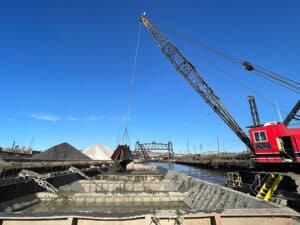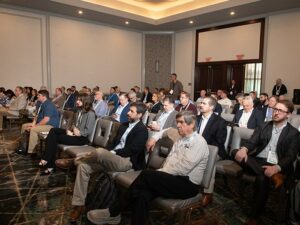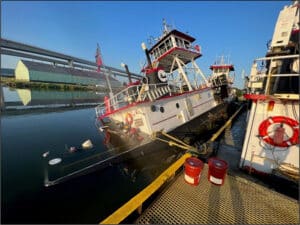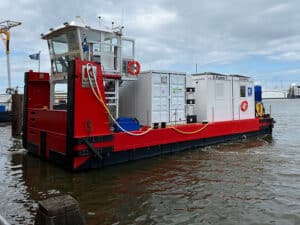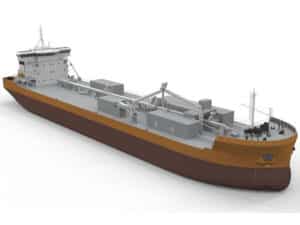
NTSB reports on $1 million fire that totaled towboat Mary Dupre
Written by Nick Blenkey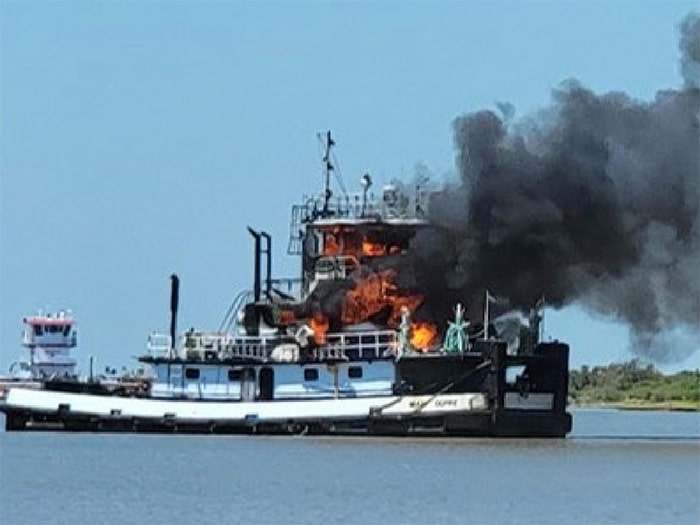
The fire aboard the Mary Dupre minutes after crewmembers abandoned the vessel. [Source: U.S. Coast Guard]
Cracks in a muffler and the substantial use of combustible materials in accommodation spaces led to a fire aboard the 48-year old towing vessel Mary Dupre on the Gulf Intracoastal Waterway near Freeport, Texas, last year, the National Transportation Safety Board reports.
The vessel was a 67.3 foot long towing vessel constructed of welded steel and built in Larose, La., in 1974 as the Mary Delgrandile. It had had several previous names and owners before it was acquired and renamed Mary Dupre by Dupre Marine Transportation in 2013. At the time of the fire, Dupre Marine Transportation operated 13 towing vessels from its facility in Houma, La.
On June 25, 2022, the four-person crew aboard the Mary Dupre departed Port Comfort, Texas, for Houston, pushing a single barge loaded with bio-diesel fuel. The following day, a fire broke out, leading to a total loss of the vessel, which was estimated at $1 million. Nearby Good Samaritan towing vessels retrieved the barge, extinguished the fire and evacuated the crewmembers. No injuries were reported.
The fire started behind the wood-paneled bulkheads in the pilot’s stateroom, which was located between the vessel’s two stacks. The stacks contained engine exhaust mufflers and piping. Investigators found cracks in the welds of the muffler located inside the starboard stack. The cracks allowed hot exhaust gases from the starboard main engine to escape from the muffler into the stack area.
Investigators also found the muffler’s exhaust blanket was disconnected. The disconnected blanket left a section of the muffler uninsulated, allowing heat to radiate into the stack area. It is likely the leaking exhaust gases from the crack in the muffler and the radiated heat from the uninsulated portion of the muffler raised the temperature in the stack area.
The crew was not aware of the cracks or disconnected blanket as the size of the stack prevented personnel from entering the space.
NTSB determined the fire aboard the Mary Dupre was caused by undetected cracks in the starboard muffler that allowed exhaust gases from an operating engine to escape and ignite wooden structures affixed to the common bulkhead of an accommodation space. Contributing to the fire damage was the substantial use of combustible materials in the joinery, outfitting and furnishings in the accommodation spaces.
In the full report, the NTSB noted:
“The NTSB has previously investigated fires aboard vessels wherein the substantial use of combustible materials in interior spaces and finishes, as well as the lack of structural fire protection, contributed to the extent of the damage each vessel sustained. Structural fire protection is a component of an overall vessel fire-protection strategy that uses passive design features in a vessel’s structure to slow the expansion of a fire from one compartment to another. Structural fire protection uses fire-resistant materials and insulation installed on the horizontal and vertical surfaces of a compartment, on doors/hatches, and in pipe and cable openings to slow the transfer of heat and smoke, thus providing additional time for evacuation and firefighting to contain and extinguish a fire. Towing vessels are inspected under the regulations in Title 46 Code of Federal Regulations Subchapter M; however, these regulations currently do not require vessel owners to incorporate structural fire protection on their vessels.
“The significant combustible load in the Mary Dupre’s interior areas, including wooden framing, joinery, paneling, and other outfitting materials, indicates that the vessel was not designed with structural fire protection. As such, these materials served as both the ignition source and a fuel source for the fire. Once the wooden framing in the pilot’s stateroom ignited, the fire spread to the attached wooden paneling on the bulkheads and overheads, then spread quickly throughout the vessel.”
Lessons learned: Inspection of exhaust systems
“Engine and other machinery exhaust systems generate heat—which can radiate from exhaust components—and are potential ignition sources,” said the report. “These systems often run through tight spaces that are difficult to access and inspect and are often located near materials or equipment that obstruct entry and direct observation. It is good practice to include these areas in periodic fire safety inspections. When conducting inspections of these systems, vessel owners and operators should consider using handheld equipment—such as inspection mirrors, video equipment, or thermal imaging equipment—to detect deficiencies.”

